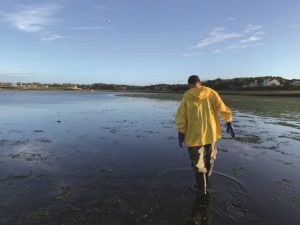WELLFLEET — Chopper Young was working on his oyster grant one day when a shrill note pierced Chipman’s Cove. Stranded in the mucky tidal flats was a woman in a kayak. She puffed on her whistle, over and over. “Fire and rescue were down there already,” Young said, “but they couldn’t reach her.”
He decided to take matters into his own hands. Wading out into the gummy harbor, Young tossed the woman a rope and tugged her out of the mud.
But not without sinking in himself, said Young, “balls deep.”
The viscous sludge in Wellfleet Harbor has loads of names. A common one is “black mayonnaise,” but, according to the Center for Coastal Studies (CCS) in Provincetown, that may be a misnomer. The term has historically referred to polluted sediment, but the stuff in Wellfleet is made of decaying marine vegetation and is not toxic. Ecologists from the CCS have rebranded it “black custard.”
Black custard has ensnared not only casual kayakers but also commercial shellfishermen, who have their own names for it. “The goo” and “black mud” are used interchangeably. “Primordial ooze” works, too.
Whatever you call it, the stuff is now being scooped from Wellfleet Harbor’s Area One — the inner harbor, between the pier and Chipman’s Cove — and removed to the Cape Cod Bay Disposal Site, 14.9 kilometers off Provincetown’s Long Point.

The contractor, Burnham Associates, employs two dredges and three scows and has been working 24/7 since Sept. 28.
The dredging aims to improve boat access and safety, and, in the long term, the shellfish dept. expects it to benefit the oyster beds — not to mention spare shellfishermen the trouble of wrestling their gear out of the mud.
Shuttle at Silver Spring
Sonya Woodman, who picks oysters commercially in the wild rather than cultivating them on a grant, was angling to find a shortcut to the tidal flats at Silver Spring Harbor, on the southern coast of Lieutenant Island. “Access to shellfish on that side of Wellfleet is very limited,” she said, so one evening, at low tide, she approached from an inlet that fed into the tidal flats.
She was looking forward to testing a new cart that can haul up to 175 pounds over sandy terrain, thanks to balloon wheels. With hardly a hiccup, Woodman made it to the harbor, settled on a reef, and picked until sunset.
She started back to her truck, retracing her steps along the inlet. But as the tide continued to ebb, “the goo got stickier and stickier,” she recalled. Before long, her haul — about 500 oysters — began sinking into the custard.
Yanking at her cart, Woodman battled the goo. Each time she freed the cart and managed to push it forward a yard or two, the mud swallowed the wheels once more. She tried crossing the marsh, but its spongy surface was cratered with pits and “mini streams” of black custard.
Woodman considered abandoning her oysters. “It was getting dark, the stars were coming out — and so were the coyotes,” she said.
When she got within 200 yards of solid ground, Woodman made a frantic shuttle run. She pulled out armfuls of shellfish, ran them to shore, dropped them off, and then hustled back to her cart for the next round.
Misadventures of ‘Mississippi Jim’
Jimmy Dale Long — or “Mississippi Jim,” as his fellow pickers call him — has had several close calls in the muck. One incident cost him some nerves in his toes.
“I was coming off the tide in the middle of winter,” he said. “Snow’s going sideways. Wind’s blowing in my ear at 30 miles per hour. It’s about 29 degrees out. All of a sudden, I’m down to my belly button in mud.
“I was going to die,” he said. “The tide was coming in.”
Squirming out of his boots, he ditched them in the frigid flats. His socks peeled away, too, leaving him barefoot as he slogged across jagged oyster shells. To this day, he said, he still can’t feel his feet.
On another occasion, Long was picking in Chipman’s Cove, “not paying attention” to his surroundings. Bad Company’s Here Comes Trouble, a favorite of headbangers, was blasting in his headset. (“The greatest album,” Long declared, “ever.”) He was unaware that most other commercial pickers had headed home. Thick fog was rolling in, and, by the time he noticed, “It was so bad that I couldn’t see my tote, which was right in front of me,” he said.
Long trudged toward his truck. He could hear cars cranking on the pier — an ominous sign that “the water was coming,” he said.
Right on schedule, the tide rose. As Long trekked, ducks floated beside him. Figuring the birds kept close to the bank, he let them guide him to shore. But the water only got deeper. To his horror, the ducks had led him astray, taking him in the opposite direction of the parking lot. He had landed in the “mud pit” in Chipman’s Cove — a notorious spot riddled with sinkholes.
“I had hip waders on,” he said. “If they get filled up, you get too heavy. And if there’s suction, then you’re a dead man.”

By then, Andy Jacob, a shellfisherman who splits time between farming and wild picking, was back at his vehicle. Across the cove, he heard a cry for help “in a thick accent.” Jacob and Long yelled back and forth through the fog until staff from the shellfish dept. arrived to assist.
“I thought the gumbo in Mississippi was bad,” Long huffed. “But no, this was just a sloppy, nasty mess.”
Getting to the Bottom
Agnes Mittermayr, a marine ecologist at the Center for Coastal Studies, has researched black custard. Starting in the fall of 2019, she worked with the Natural Resources Advisory Board in Wellfleet to report on the harbor sediment. Mittermayr has discussed Wellfleet’s custard with colleagues “around the world.” Time and again, she said, they commented that the muck had some unique qualities.
Namely, the grains of black custard are remarkably fine. Compared to other types of sediment, “Gravity doesn’t affect it the same way,” Mittermayr said. Finer sediment generally needs more time to sink and settle out — yet something in Wellfleet Harbor hastens this process, allowing the particles to congeal into black custard.
Mittermayr and her colleagues are still investigating what may be driving the formation of the goo, but phytoplankton are a part of their working hypothesis. “Some research suggests that certain types of phytoplankton might attach to the sediment particles and create a ‘heavier’ conglomerate that settles down faster,” she said. “This theory would go well with the high amount of organic matter we found in the black custard.”
In Case of Emergency
While the dredge chugs away, Jacob suggested embracing a shark-like mentality to stay one step ahead of the black custard. “I try to keep a steady pace until I’m well out of the muck,” he said. “Keep moving forward — or you’re bound to sink.”
This requires deliberate footwork. The tidal flats are dynamic; patches of goo can “appear and disappear,” Woodman observed, depending on the geological whims of the harbor — and the goings-on of mariners. Once, she saw a large hole in the sandbar, gouged out by a boat motor. “If the black ooze moves in, and if someone’s walking over that, then it’s basically a booby trap,” she said.
Should the goo grab you, Woodman advises finding some leverage. Grasp at a kayak or a canoe — even a basket will do. Then, lean while twisting your trapped leg until the suction releases its grip. And if the tide has yet to come in, take a breather. Dislodging oneself is strenuous business.
“You actually have to be in shape,” Long remarked. “Especially when you’re also pulling two hundred pounds of clams or oysters.”
In case of emergency, getting out of your boots is a good idea. They will join dozens of other abandoned footwear and baskets on the flats, “but this way,” Woodman pointed out, “your entire body isn’t stuck.”
To coax the smelly muck out of clothing, a turn in the outdoor shower is ideal, followed by an afternoon under the sun. “That stuff turns into a powder,” Woodman said. “And then you can just bash it out.”



